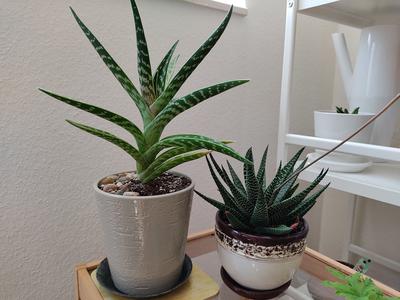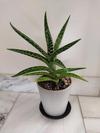by Zach Morgan
(London, United Kingdom)




The aloe vera plant is one of the most widely used medicinal plants on Earth. It’s an easygoing, attractive and popular plant to grow at home. But in order to keep your aloe plant happy you need to know the basics. Caring for such a plant is simple, and with a little effort, it can live a long life.
Place the aloe plant in a sunny spot
Aloe vera will grow healthy if it’s exposed to a good amount of sunlight. Opt for places with as little shade as possible. It’s best to position the plant on a south-facing window. Also, rotate it from time to time so that it gets equal sun exposure on its leaves. You can also move the plant outdoors in the warm months when there is no chance of frost. It’s good to know that Aloe is made up mostly of water, and even a slight frost can turn it to mush.
When choosing the spot for the plant, keep in mind that too much direct sunlight can burn its leaves, turning them brown. On the other hand, if the Aloe doesn’t get enough sunlight its leaves will become high, start thinning out and just look unpleasant.
Proper watering is essential
In its own habitat Aloe vera grows in desert climates and rarely gets watered by rain. Therefore when looking after one at home, wait until the soil is dry, then water gently and deeply. Never leave your aloe plant soaked in water and make sure the bottom of the pot it’s in has proper drainage.
If you overwater your Aloe Its roots can become decomposed. To avoid this, water your plant once every 3-4 weeks and even less frequently in cold seasons. When in doubt, it’s better to water less than more.
Aloe vera holds water in its leaves, so if you notice them becoming thin and curled, this is a sign that it needs water. Check the soil for drought with your fingers and if it’s dry, give it some water.
Be sure to wait until the soil is completely drained between each watering to prevent root rot.
Go with cactus potting soil
The best potting soil for aloe plants is one that dries up fast, they don’t do well in regular potting soil. So either mix your soil with perlite, pumice or terracotta or just buy cactus potting soil from the local nursery.
When choosing a pot, get one two or three times bigger than aloe’s root, as they love to have room to spread. Buy a new pot after several months, when you notice your plant is outgrowing it.
Aloe vera doesn’t have to be fertilized
Although Aloe plants don’t need to be fertilized, applying small amounts of phosphorous-heavy fertilizer during the growing season will boost its health. Aloe vera grows actively from April to September so if you want to do some fertilizing do it in that time frame
If you want to use your Aloe plant’s gel, give it some organic fertilizer. You can dilute this with water so that the plant gets fertilized when you’re watering it.
Beware, that over-fertilizing can sometimes do more harm than good. Remember that Aloe plants fall into a state of dormancy during the cold season, so don’t bother to fertilize or water them during that period.
Keep an eye out for insects
Well-grown Aloe plants don’t usually have problems with insects but can sometimes get attacked by mealybugs. These bugs are tan brown and flat, and they love to suck aloe vera sap. When treating the plant for mealybugs avoid using chemical pesticides as Aloe vera plants are sensitive species. Use horticultural non-toxic insecticidal spray instead.
Bear in mind that if your plant has bugs it’s mostly because of dead leaves, so make sure you remove them.
Harvest only when the plant reaches maturity
When it’s time for harvest, start with the outermost leaves, cut them as close to the bottom as possible and be careful to not harm the roots. If you want to clone your Aloe plant to produce a second one, find where the branches are attached to the mother plant. Then lift the branches out of the soil for a couple of days. This will help heal the cut-off area by forming calluses which prevent rotting.
Keep the babies in a warm place with indirect sunlight while they’re healing. When they are ready to pot, make sure the soil is well-drained. Place them in a sunny spot and wait about a week and a half before watering.
See? Growing Aloe vera is not that hard, and it can provide your family with a plant that can come in handy in many situations. Its gel can be used to relieve pain from scratches and also treat minor burns.
Aloe vera is proven to contain vitamins that boost the immune system, it can also help with acne and dehydrated skin.
Bio:
Zach Morgan is a gardener and plant expert at UK based gardening company – Allan’s Gardeners. His years of experience led him to start writing tips and tricks about many gardening topics. But he realizes that his greatest weakness is plants and especially succulents. Over the year he becomes obsessed with them, and they are Zach’s new hobby.
Comments for Aloe vera plant care for beginners
Feb 17, 2021
Medicinal benefits
by: Michelle
Greetings. I live in southern Mexico and I appreciate your advice as I am starting my own garden of aloe. The reason being that the local acupuncture doctor usually advises cutting one stalk, deskinning it, and pulverize and mixing it with clay as a compact on areas with muscle problems.
You see, as a chemist and doctor, he knows that aloe contains steroids, which help to relax the muscles. the aloe with the whitish spots is skinnier, but contains more of the medicine!


